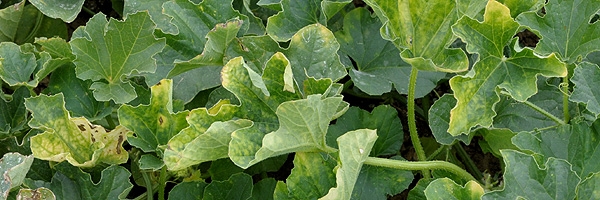
Cucurbit aphid-borne yellows virus (CABYV)
transmitted by aphid
(Polerovirus, Luteoviridae)
CABYV, like all Poleroviruses , is aphid-transmitted in the persistent mode and is restricted to the plant phloem. It causes jaundice-like diseases in cultivated Cucurbits. This virus was described in France in 1989, but it was probably present in cultures for a long time, since it was detected in samples taken several years earlier. This situation is partly explained by the fact that the study and detection of this type of virus is quite delicate and by the confusion of the symptoms caused by CABYV with those caused by mineral deficiencies in particular. Since reliable serological or molecular tests have been developed, this virus has been reported in most of the countries where Cucurbitaceae are cultivated in the world, except the West Indies and the northern part of America. from South.
CABYV is the second most common virus in Cucurbitaceae crops in France and it is probably one of the most common viruses in these species worldwide. A survey carried out from 2004 to 2008 in the main French production areas showed that CABYV was present in 41% of 2,660 samples analyzed, mainly on courgette (51% of samples tested), squash (38%), melon (36% ), but also cucumber (19%). We observed a regular increase in the frequency of this virus during these 5 years of observation: present in 20% of samples in 2004, it was detected in 57% of samples in 2008.
However, despite its frequency, this virus is not very serious in France. It can weaken plants and lead to significant reductions in the number of fruits in cucumber and melon, but it does not affect their quality.
CABYV has paraspheric particles approximately 25 nm in diameter. The viral genome consists of a single-stranded RNA molecule of positive polarity.
Other Poleroviruses infecting Cucurbits
Two species of Polerovirus have been described, in addition to CABYV, in Cucurbits in China and Taiwan. These are the Melon aphid-borne yellows virus (MABYV) and the Suakwa aphid-borne yellows virus (SABYV). These two viral species close to CABYV cause similar yellows in Cucurbitaceae. A recombinant virus * between CABYV and MABYV has been reported in Taiwan.
There is a strong convergence between the symptoms of jaundice caused by CABYV and those caused by two viruses transmitted by whiteflies, the Beet pseudoyellows virus (BPYV) and Cucurbit yellow stunting disorder virus (CYSDV). In France, CABYV is very common in field cultivation, but can also be found in cultivation under cover, while BPYV and CYSDV are mainly found under cover. The presence of large populations of vectors (aphids or whiteflies) can then guide the diagnosis. It should be noted that deficiencies, in particular in magnesium, also cause leaf yellows, which complicates the visual diagnosis. Commercial diagnostic kits ELISA are available as well as primers molecular diagnostic (RT-PCR).
* The recombination is an exchange of genetic information between two viruses or virus strains.





